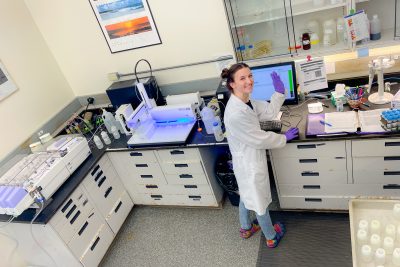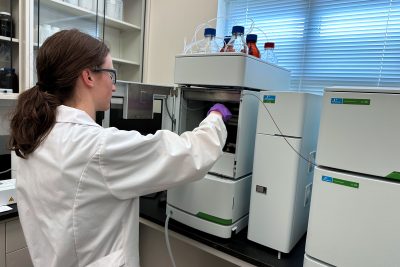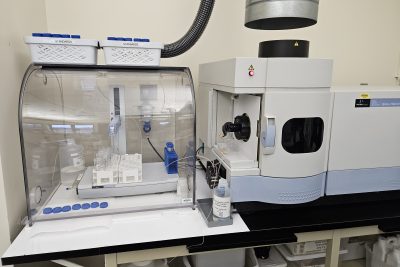
For Clients: Submissions
The Center for Environmental Sciences and Engineering (CESE) at the University of Connecticut is a full-service research and analytical chemistry facility, supporting the needs of academic, government, commercial, and non-profit organizations.
CESE Environmental Chemistry Laboratories benefit from a comprehensive capacity to conduct physical and chemical analyses of bioactive compounds including cannabinoids and persistent or nontraditional environmental pollutants in biological tissues, surface and ground waters, sediments, soils, and hazardous waste. The state-of-the-art laboratories are staffed by experienced professionals that provide timely analytical results of a high quality, under the umbrella of a comprehensive quality management system, certified by the State of Connecticut Department of Public Health.
How It Works
How to Submit Samples
Clients can drop off samples at the CESE Laboratories on the UConn Storrs campus or ship samples via UPS or FedEx (next-day service) to: 3107 Horsebarn Hill Road, Unit 4210, Storrs, CT 06269
To ensure sample integrity, please store samples in a cooler with ice packs until they are delivered to the lab. All samples shipped to the lab should be frozen prior to shipment or shipped in a cooler with ice packs.
How to Submit a Chain of Custody form
All samples must be accompanied by a completed Chain of Custody (CoC) form. This form provides CESE with the required information to correctly handle and process your samples, including sample identification; location, date, and time of collection; preservation type; sample matrix; and requested analytical tests.
»» Before dropping off or shipping your samples, please submit your Chain of Custody form online. Please complete all fields and upload your CoC file(s) in Microsoft Excel format.
Chain of Custody submission
Sample Drop-Off Hours
CESE is open to receive samples Monday through Friday between 9:00 a.m. and 4:30 p.m. Sample drop-off may be available outside of normal hours with prior approval. Hours may change due to holidays and inclement weather.
Standard Turnaround Time
At CESE we make every attempt to provide sample results within a 28-day turnaround time. There may be certain circumstances when results cannot be reported within this timeframe, and we will do our best to communicate this as soon as possible.
We may be able to accommodate expedited turnaround time, at an additional charge and with prior approval. If you wish to request expedited turnaround time, please indicate this in your Chain of Custody submission form. The CESE Laboratory Director will let you know if we are able to accommodate your request.
How to Obtain Sample Bottles
CESE does not charge for sample bottles; however, we do not have a courier service nor do we ship to clients. Sample bottles can be picked up during our regular business hours. We recommend contacting us in advance to ensure availability.
Rates/Billing
Organics Rates
Nutrients Rates
Metals Rates
CESE Laboratory Billing FAQ
Deliverables
CESE can provide electronic data deliverables in Excel or PDF format. CESE is more than willing to customize the format to meet customer needs.
Contact Us
For laboratory information, price quotations, or other questions please contact:
Christopher Perkins, Laboratory Director
Phone: (860) 486-4015
Email: christopher.perkins@uconn.edu
Laboratories and Instrumentation
CESE has three divisions with extensive analytical expertise and instrumentation in environmental analysis.

Nutrients Division
The Nutrients Division determines concentrations of nutrient series, saline water samples, as well as in solid matrices. This laboratory is certified by the Connecticut Department of Public Health for the analysis of nutrients in non-potable waters.

Organics Division
The Organics Division identifies and quantifies trace organic compounds in water, soil, sediment, and tissue at the part-per-billion (ppb) and part-per-trillion (ppt) level using standard EPA and NOAA methods as well as CESE-developed methods.

Metals Division
The Metals Division analyzes trace elements in water, soil, sediment, tissue, and filters at the part-per-billion (ppb) level using EPA and NOAA methods.